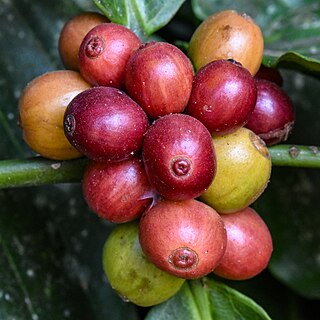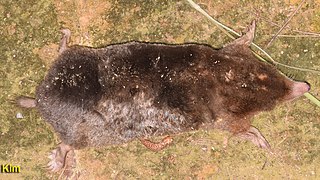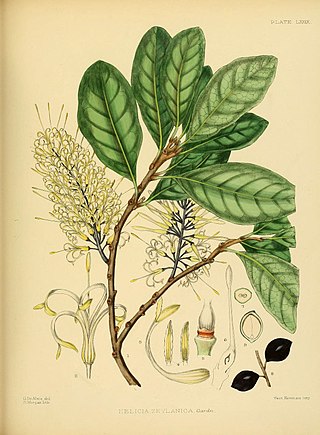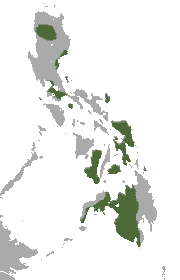
Coffea canephora is a species of coffee plant that has its origins in central and western sub-Saharan Africa. It is a species of flowering plant in the family Rubiaceae. Though widely known as Coffea robusta, the plant is scientifically identified as Coffea canephora, which has two main varieties, robusta and nganda.

Agathis robusta, commonly known as Dundathu pine, kauri pine, Queensland kauri (pine), Australian kauri (pine) or smooth-barked kauri, is a coniferous tree in the family Araucariaceae. Although some common names use the word 'pine' it is not a true pine, having leaves rather than needles. It has a disjunct distribution, occurring in Papua New Guinea and two locations in Queensland, Australia.

Eonycteris is a genus of megabats found in Asia. They are the only members of the tribe Eonycterini. Species within this genus are:
The robust climbing salamander is a species of salamander in the family Plethodontidae. It is found in Costa Rica and Panama. Its natural habitats are subtropical or tropical moist lowland forests and subtropical or tropical moist montane forests. It is threatened by habitat loss.
Conraua robusta, the robust giant frog or Cameroon slippery frog, is a species of frog in the family Conrauidae found in western Cameroon and eastern Nigeria. This species is congeneric to the goliath frog, the largest known frog species in the world.

Buergeria robusta is a species of frog in the family Rhacophoridae. It is sympatric with Buergeria japonica but is much larger in size.

The mountain mouse-warbler is a species of bird in the family Acanthizidae. It is found in Indonesia and Papua New Guinea, where its natural habitat is subtropical or tropical moist montane forests.

The Ussuri mole or large mole, is a species of mammal in the family Talpidae, formerly treated as a subspecies of the Japanese mole. It is found in China, North Korea, South Korea, and Russia and lives in a long burrow, seldom emerging on the surface of the ground during the day.

The orange nectar bat is a species of bat in the family Phyllostomidae. It is found in Colombia, Costa Rica, Ecuador, Nicaragua, Panama, Peru, and Venezuela.

The lesser tube-nosed bat is a species of megabat in the family Pteropodidae. It is native to two of the Maluku Islands in northern Indonesia.
Sauvagella robusta is a small species of fish in the family Clupeidae. It is endemic to the Amboaboa and Mangarahara River Basins in northern Madagascar. This relatively slender fish reaches a length of 6.8 cm (2.7 in), and is overall pale yellowish with silvery on the lower parts. Its current conservation status is unclear, but the cichlid Ptychochromis insolitus, which is highly threatened from habitat loss, is native to the same region. Sauvagella robusta is known to survive at least in Lake Tseny.

Helicia is a genus of 110 species of trees and shrubs, constituting part of the plant family Proteaceae. They grow naturally in rainforests throughout tropical South and Southeast Asia, including India, Sri Lanka, Indochina, Peninsular Malaysia to New Guinea and as far south as New South Wales.

Kalanchoe robusta is a species of plant in the family Crassulaceae. It is endemic to the Yemeni island of Socotra. Its natural habitat is on rocky slopes and amongst limestone boulders in dwarf shrubland and low succulent shrubland at an altitude of 300–750m. While it is listed by IUCN as belonging to the order Rosales, Kalanchoes and other Crassulaceae are more usually placed in Saxifragales.

The cave nectar bat, dawn bat, common dawn bat, common nectar bat or lesser dawn bat is a species of megabat within the genus Eonycteris. The scientific name of the species was first published by Dobson in 1871.

The greater nectar bat or greater dawn bat is a species of megabat within the genus Eonycteris. It is found in Brunei, Indonesia, Malaysia, and the Philippines. Its range is limited and includes Luzon to Maripipi in the Philippines and scattered parts of Borneo including Tuaran and Ranau in Sabah; Bau, Kuching and Bintulu in Sarawak.

Acropora robusta is a species of acroporid coral found in the Red Sea, the Gulf of Aden, the southwest and northern Indian Ocean, the central Indo-Pacific, Australia, Southeast Asia, Japan, the East China Sea and the oceanic west and central Pacific Ocean. It occurs in tropical shallow reefs, mainly along margins that are exposed to the action of strong waves, and can be found at depths from 1 to 8 metres. It was described by Dana in 1846.
Mesocnemis robusta is a species of white-legged damselfly in the family Platycnemididae.

Pendlebury's roundleaf bat is a species of bat in the family Hipposideridae. It was previously considered a subspecies of H. turpis, but has now been raised to full species level. It is endemic to Thailand and is found in limestone karst areas.














